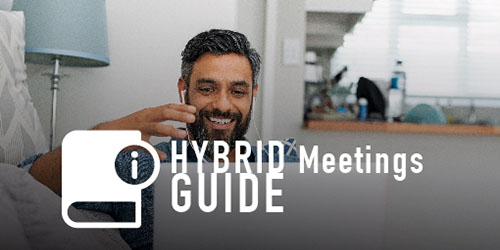A hybrid meeting is any meeting where some of the participants are together in person while others are attending virtually. The digital age has made it possible to connect those in the office with those who are 1000 miles away.
In the aftermath of the pandemic, the hybrid system has become a lot more common. Many people have returned to in-person work while others have decided to continue working from home. At times, social distancing regulations have made this a necessity.
However, some organisations have found that there are advantages to hybrid working that are not worth losing.
What are the advantages of hybrid meetings?
According to Aileen Evans of Grand Housing Union, ‘hybrid meetings are about flexibility and underpinning the organisational culture’. They are essentially a way of ensuring flexibility and supporting creative collaboration.
The advantages of hybrid meetings are simple: they offer the opportunity to bring your team together. Although the past year has been an extreme example, it has shown how important it is for organisations to adapt to their members’ needs.
Studies have shown the productivity of remote work. It allows employees to work the hours that suit them which can create a better environment. Many Boards have members located around the country or world and do not want to waste time flying them in every week.
However, remote work on its own does come with some challenges. Many people enjoy being in the office and engaging in face-to-face collaboration. In particular, the most senior members of the team may wish to attend meetings in person so they can establish a clear order and maintain consistent processes.
Hybrid meetings are a great solution to this challenge. They allow everyone on the team to work in the way that is best for them. For example, if someone is invited to an irregular meeting on a one-off chance to share their expertise, it may be easier for them to access the meeting virtually.
Hybrid meetings are also helpful to create a fair working environment. Not everyone has a good space from home in which to conduct meetings. Some might be next to a busy road or have family walking in and out. A hybrid meeting space offers your team the opportunity to enter the office if it would support their work.
How to run an effective hybrid meeting?
- Preparation
When running a hybrid meeting, you have to be careful when coordinating the participants. Make sure you give everyone the same amount of attention: whether they are in person or 1000 miles away.
One example of this is in compiling the meeting packs. Having people in person may encourage you to hand them out at the last minute. However, this might not work at all for the remote participants. Make sure to give plenty of time and ensure that any updates are passed on to everyone involved.
Be careful when selecting a location for your meeting. In providing guidance for housing associations, the NHF stresses the ‘ongoing need’ for strict cleaning regimes and good ventilation. This is important even when there are fewer people in the room.
In hybrid meetings, you should also take care when preparing the technology you will use. Hybrid meetings rely on virtual collaboration software. Make sure to test the technology before you start and check that everyone feels comfortable with using it. Having a small issue can ruin the momentum of your meeting and make it hard to recover.
- Ease Into The Process
Hybrid meetings are a new experience for most people. The pandemic introduced many to the new normal of remote meetings for the first time. Now, it may seem like you have to get used to a new way of working all over again. Although hybrid meetings can simple, there is no denying the fact they are different from in-person meetings.
Start by implementing hybrid meetings in a low-pressure environment. Even if you have tested the software, give yourself time at the start of the meeting to check that everything is working as it should. You may even want to make a point on the agenda. This way, you can ensure there are no problems that will waste admin time later.
- Ensure Accessibility
One of the main challenges of hybrid meetings is ensuring everyone is on the same page. Make an active effort to check everyone is engaged in the meeting and following the topics of discussion.
The ICSA guidelines state that you should ensure equal opportunity to everyone involved in the meeting. This means waiting until the virtual as well as the in-person attendees are present.
You should have participation plan for every item on the agenda. Ensure that there is no content or action that is restricted from virtual attendees. One example of this is voting. If you are going to vote on resolutions, everyone in the room should be able to make their opinion heard in a professional manner.
It’s also important to pay attention to your Board members’ individual needs. When planning the meeting, check the time zones of your team! A meeting at 9 am GMT will take place at 5 am EST, which might leave virtual attendees at a disadvantage.
- Encourage Team Spirit
The challenge of ensuring everyone is on the same page also applies to more casual interactions. Before a meeting starts, there is often a more informal meeting where attendees chat about their current projects and goals. If this is something that takes place in your company, make sure virtual attendees are not excluded. After all, team spirit is an important way to empower your team.
Sometimes, the solution to this is as simple as getting everyone to introduce themselves. Employees who are working remotely may not come into contact with the other team members as often. It might also be worth leaving space at the beginning and end of the meeting for ‘water cooler’ conversations.
- Don’t Forget Security
Security is complicated and the average person on the street may not understand how 256-bit encryption works (however useful it is in keeping your data secure). However, this is no excuse when it comes to your company’s important documents. Do not let security standards slip because you’re working in a hybrid working environment.
The truth is, digital security is stronger than paper documents. This is because a paper document can be picked up and read by anyone who speaks the language. In contrast, virtual security is much stronger as is impossible for documents to ‘accidentally’ go missing.
In this case, even the in-person members of a hybrid meeting will benefit from purpose-built software. An effective. Board Portal will allow you to alter permissions as you go. This means that Board Members can only access the documents they need to, without confusion.
Before organising a hybrid meeting, you should also check your company articles to make sure your organisation allows for compliant hybrid meetings.
- Invest In The Right Software
Convene is a Board Portal solution that aims to make hybrid meetings easier. Our secure Document Library allows eyes-only access to essential files, both online and offline, at a moment’s notice. From planning the meeting to creating a secure audit trail, Convene is designed to support your whole team.
Discover our full range of features to see how we can help your organisation. If you are interested in learning more, please do not hesitate to get in touch or book your free demo now!








